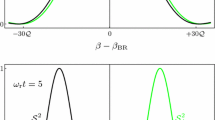Summary
We describe an approximation we have used to compute gain, saturation and electron statistics at high power in the Stanford free-electron laser.
Riassunto
Si descrive un'approssimazione usata per calcolare il guadagno, la saturazione e la statistica degli elettroni ad alta potenza nel laser a elettroni liberi di Stanford.
Резюме
Мы описываем приближенный метод, который исполязуется для вычисления усиления, насыщения и статистики электронов при больших мощностях в свободном электронном лазере с Стенфорде.
Similar content being viewed by others
Abbreviations
- e :
-
electron charge (4.8·10−10 statcoulomb)
- m :
-
electron mass (9.11·10−28 g)
- c :
-
speed of light (3·1010 cm s−1)
- ℏ:
-
Planck's constant (1.05·10−27 erg s)
- K :
-
Boltzmann's constant (1.38·10−16 erg K−1)
- r :
-
exact electron position
- r a :
-
approximate electron position calculated by using the approximation described in the text for the analysis of the electron motion in the presence of the optical field
- δr=r−r a :
-
position error
- \(\delta r_1 = (\delta r \cdot \hat z)\hat z\) :
-
longitudinal position error
- δr ⊥=δr−δr ⊥ :
-
transverse position error
- \(\beta= \dot r/c\) :
-
exact normalized electron velocity
- β0 :
-
normalized electron velocity when the optical field is absent
- \(\hat \beta _0 = \beta _0 /|\beta _0 |\) :
-
unit vector for normalized velocity when the optical field is absent
- βa :
-
approximate normalized velocity, calculated by using the approximation described in the text to analyze the electron motion in the presence of the optical field
- \(\beta _\parallel = (\beta _a \cdot \hat z)\hat z\) :
-
normalized approximate longitudinal velocity
- β⊥=βa−β∥ :
-
normalized approximate transverse velocity
- δβ=β−βa :
-
normalized velocity error
- \(\delta \beta _\parallel = (\delta \beta \cdot \hat z)\hat z\) :
-
normalized longitudinal-velocity error
- δβ⊥=δβ−δβ‖ :
-
normalized transverse-velocity error
- P :
-
exact electron momentum (g cm s−1)
- P 0 :
-
electron momentum when the optical field is absent
- P a :
-
approximate electron momentum calculated by using the approximation described in the text for the analysis of the electron motion in the presence of the optical field
- δp=p−p a :
-
momentum error
- \(\delta p_\parallel = (\delta p \cdot \hat z)\hat z\) :
-
longitudinal-momentum error
- δp ⊥=δp−δp‖:
-
transverse-momentum error
- \(\gamma = \sqrt {p^2 + m^2 c^2 } /mc\) :
-
exact normalized electron mass-energy
- γa :
-
approximate electron mass-energy, calculated by using the approximation described in the text for the analysis of the electron motion in the presence of the optical field
- δγ = γ-γa :
-
error in normalized energy.
- ω:
-
optical frequency (s−1)
- k :
-
optical wave vector (cm−1)
- \(\hat k = k/\left| k \right|\) :
-
unit wave vector
- E :
-
optical electric field (statvolt cm−1)
- B :
-
optical magnetic field (G)
- E 0 :
-
polarization vector for optical electric field
- S lab :
-
optical power density (erg cm−2 s−1)
- λq :
-
magnet period (cm)
- L :
-
length (cm)
- B 0 :
-
static magnetic field (G)
- B 0 :
-
polarization vector for the static magnetic field
- A :
-
vector potential for the static magnetic field
- \(A_ \bot = A - (A \cdot \hat z)\hat z\) :
-
transverse component of vector potential.
- t :
-
dummy variable for time
- T :
-
total interaction time (s)
- K D :
-
Debye wave number
- n 0 :
-
electron density (cm−3)
- τ:
-
temperature (K).
References
J. M. J. Madey andD. A. G. Deacon: inCo-Operative Effects in Matter and Radiation, edited byC. M. Bowden, D. W. Howgate andH. H. Robl (New York, N. Y., 1977), p. 313.
R. M. Phillips:IRE Trans. Elect. Dev.,1, 231 (1960).
F. A. Hopf, P. Meystre, M. O. Scully andW. H. Louisell:Opt. Comm.,18, 413 (1976);F. A. Hopf, P. Meystre, M. O. Scully andW. H. Louisell:Phys. Rev. Lett.,37, 1342 (1976);H. Al-Abawi, F. A. Hopf andP. Meystre:Phys. Rev. A,16, 666 (1977).
W. B. Colson:Phys. Lett.,64 A, 190 (1977).
A. Bambini andA. Renieri:Nuovo Cimento,21 B, 399 (1978).
V. N. Baier andA. I. Milstein:Phys. Lett.,65 A, 319 (1978).
Author information
Authors and Affiliations
Additional information
Traduzione a cura della Redazione.
Переведено редакцией.
Rights and permissions
About this article
Cite this article
Madey, J.M.J., Deacon, D.A.G., Elias, L.R. et al. An approximate technique for the integration on the equations of motion in a free-electron laser. Nuov Cim B 51, 53–69 (1979). https://doi.org/10.1007/BF02743696
Received:
Published:
Issue Date:
DOI: https://doi.org/10.1007/BF02743696




